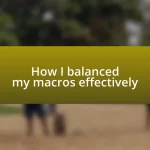Key takeaways:
- Physical therapy fosters both physical recovery and emotional resilience through personalized care and encouragement.
- Consistency in therapy is crucial for achieving lasting results, building habits, and overcoming setbacks.
- Incorporating techniques like stretching and resistance exercises enhances recovery and overall well-being.
- A strong support system and self-reflection are vital for maximizing recovery and maintaining motivation.
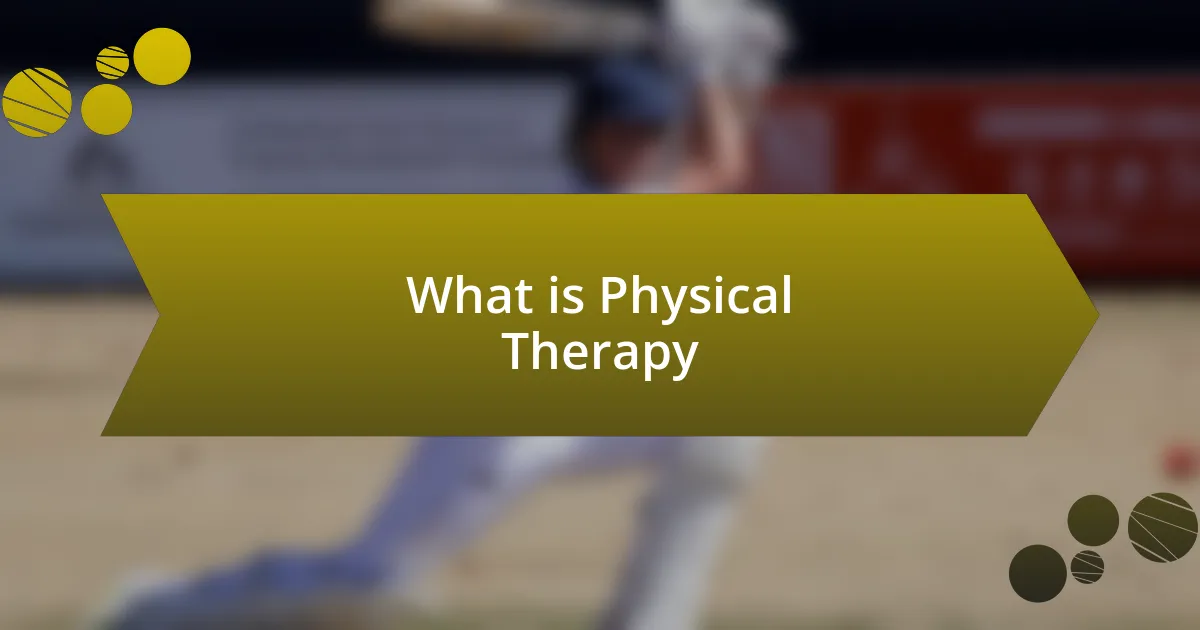
What is Physical Therapy
Physical therapy is a health care specialty focused on helping individuals restore movement and function following injury or surgery. I recall my first session, feeling a mix of anxiety and hope. The therapist not only assessed my physical limitations but also listened to my concerns, which made me realize how holistic the approach really is.
At its core, physical therapy involves tailored exercises, manual therapy, and patient education, empowering people to take charge of their rehabilitation. I was amazed at how each session felt like a personal journey rather than just a series of prescribed movements. Have you ever thought about how much our bodies can heal when given the right tools and guidance?
Through consistent practice and tailored support, physical therapy can lead to significant improvement in mobility, strength, and overall quality of life. I remember one particular exercise that felt impossible at first. Yet, with each repeat, I found not just physical recovery but a renewed sense of self-belief blossoming within me. That’s the true magic of physical therapy—it nurtures both the body and spirit.
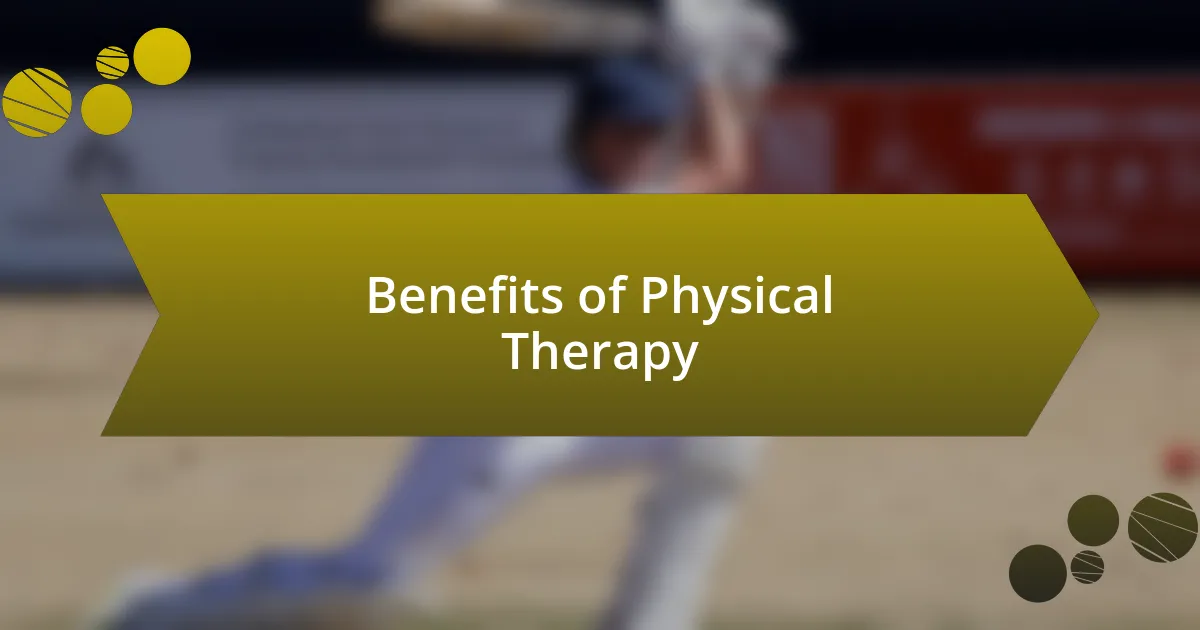
Benefits of Physical Therapy
Physical therapy offers an array of benefits that extend beyond physical recovery. As I progressed through my sessions, I discovered how each exercise not only improved my physical capabilities but also alleviated my mental stress. It was fascinating to see how movement could lift my spirits; I often left therapy feeling more energized and optimistic.
Here are some key benefits of physical therapy:
- Enhanced mobility and flexibility: I could easily touch my toes after practicing specific stretches.
- Pain relief and management: The targeted techniques helped alleviate chronic discomfort that I thought was permanent.
- Improved balance and coordination: I became more confident while navigating stairs, a huge victory for me.
- Increased strength: I felt empowered lifting weights that once seemed daunting.
- Personalized care: Every session was crafted with my individual needs in mind, making it feel like a tailored fitness program.
Each of these benefits not only transformed my body but also reshaped my attitude toward health and wellness. The progress I made was not just physical; it reshaped my entire outlook on life.

My Personal Experience
My journey through physical therapy was truly transformative. I recall one particular session where I struggled with a specific movement, feeling a wave of frustration wash over me. My therapist, noticing my struggle, encouraged me to take a breath and focus on the small wins. That moment taught me the power of patience and how progress, no matter how small, is still worthwhile.
Another significant experience I had involved working on my core strength. The first time I completed an exercise without assistance, I felt a rush of pride. It was more than just completing a task; it was a reminder of how far I’d come, both physically and mentally. In that moment, I realized that physical therapy was not just about healing my body, but also about building resilience and self-belief.
Reflecting on my time in therapy, I discovered an unexpected emotional bond with my therapist. Their unwavering support provided a sense of reassurance during moments of doubt. This experience taught me that healing often involves teamwork, and having someone who believes in you can make all the difference.
| Key Aspects | Personal Experience |
|---|---|
| Encouragement | Learning patience during a challenging session helped me recognize the importance of small victories. |
| Strength Achievement | A moment of pride came from completing a core exercise without assistance, highlighting my physical and mental progress. |
| Supportive Bond | Building a connection with my therapist reinforced the value of teamwork in the healing process. |

Key Techniques and Exercises
One technique that really stood out to me during my therapy sessions was the use of resistance bands. The first time I utilized them, I underestimated their effectiveness. I found myself sweating and pushing harder than I expected, which sparked a sense of determination within me. It made me realize that sometimes, the simplest tools can yield the most profound results.
Incorporating balance exercises was another key piece of my recovery. I remember the first session where I stood on one leg, wobbling like a newborn deer. It was both frustrating and funny, yet it taught me the importance of stability in everyday activities. How often do we take our balance for granted? That experience made me appreciate not just the physical aspect of therapy, but also how it connects to our overall well-being.
Stretching, in particular, became my sacred ritual. I would arrive at the clinic feeling tense and leave feeling liberated. One day, as I held a deep stretch, I couldn’t help but notice how it mirrored my emotional release. I asked myself—what if we approached our emotional blocks with the same intention as our physical restrictions? This simple technique opened my mind to the idea that healing is multifaceted, affecting both body and soul.
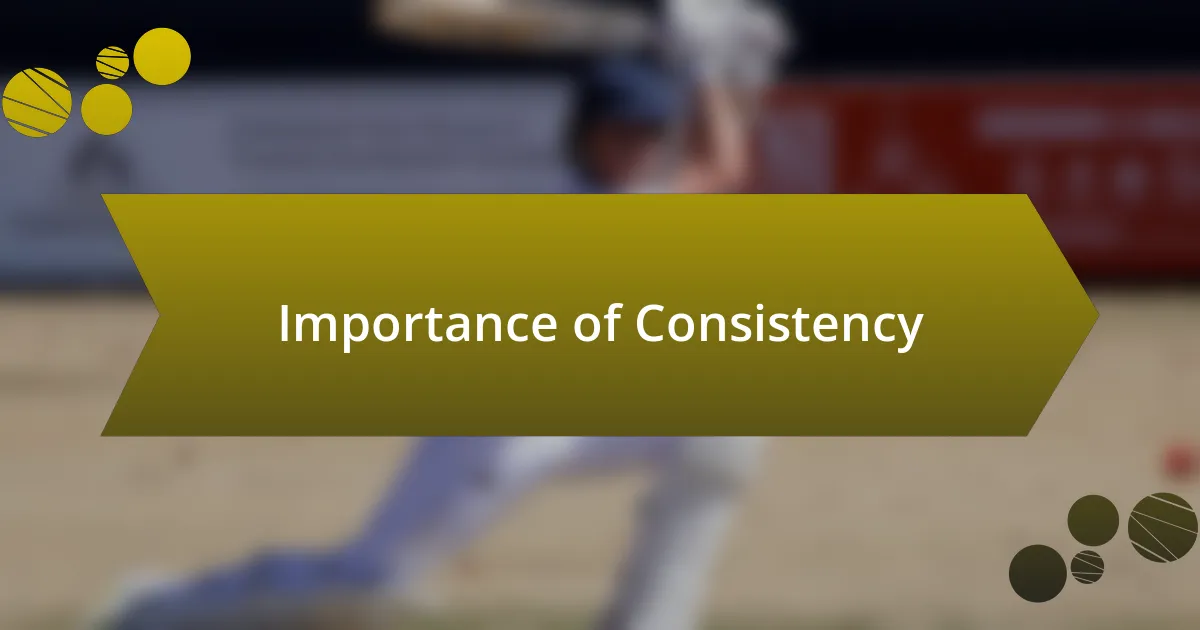
Importance of Consistency
Consistency in physical therapy plays a pivotal role in achieving lasting results. I vividly remember days when I felt discouraged and debated skipping my exercises. Yet, I discovered that those moments of doubt were often when I needed to push through the most. The gradual progress I made over weeks was a constant reminder that regularity, even on tough days, truly amplifies the benefits of my efforts.
Another essential aspect of consistency is the ability to build habits. Initially, sticking to a routine felt tedious. But as I persevered, I found that the exercises became almost second nature. This transformation enabled me to not just recover physically but also instilled a sense of discipline in other areas of my life. Have you ever noticed how small daily commitments can lead to significant changes over time? I certainly have; it’s a testament to the power of persistence.
Moreover, I realized that the emotional journey intertwined with my physical progress was just as critical. Each session felt like a puzzle piece falling into place, reinforcing my belief that healing isn’t just a physical endeavor. The consistency I maintained helped me tackle setbacks with resilience and positivity. Reflecting on this, I ask myself—what else in life requires that same level of dedication to flourish? It’s a perspective shift that underscores the importance of staying committed to the process.
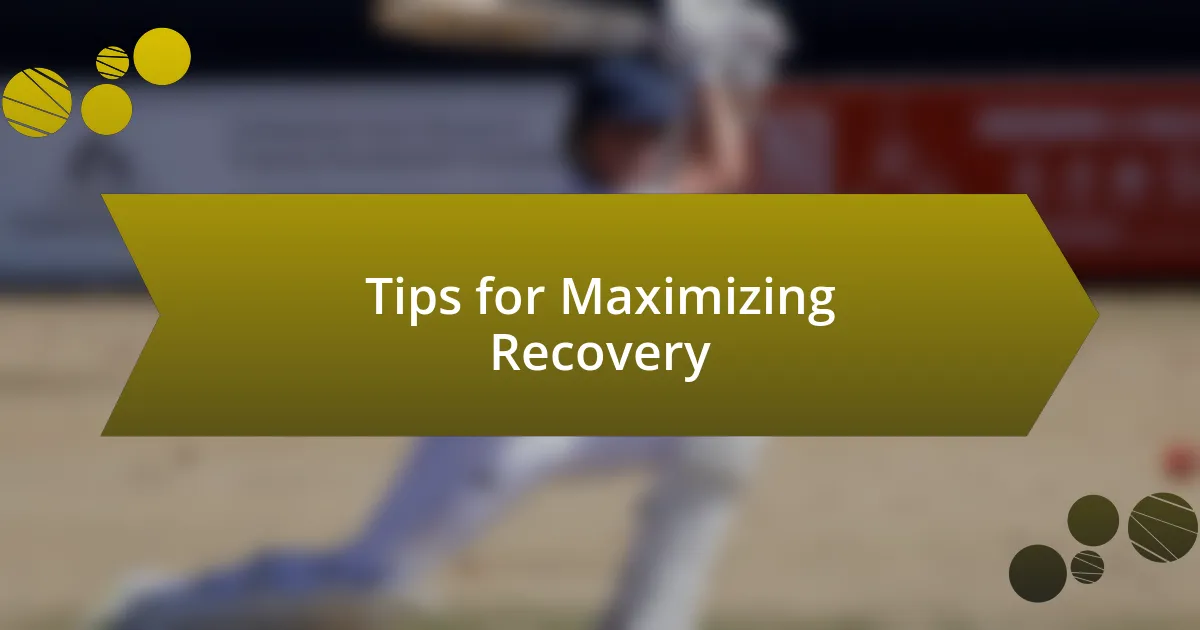
Tips for Maximizing Recovery
It’s essential to pay attention to how you feel during your recovery process. I found that keeping a journal, jotting down daily progress and challenges, helped me identify patterns in my pain and mobility. This reflection not only kept me accountable but also allowed me to communicate more effectively with my therapist. Have you ever noticed how writing can clarify your thoughts or feelings? It certainly did for me, transforming abstract feelings into actionable insights.
Incorporating rest days into your routine is just as crucial as the exercises themselves. I recall a week when I pushed myself too hard and ended up feeling more fatigued than improved. Learning to listen to my body taught me the importance of balance and recovery. It made me realize that sometimes stepping back is what propels you forward. Have you experienced setbacks that turned out to be blessings in disguise? For me, giving myself permission to rest was a game-changer.
Finally, I emphasize the value of a strong support system during recovery. I was fortunate to have friends and family who cheered me on and helped maintain my motivation. Sharing my journey with them made the process less lonely and even enjoyable at times. Have you ever felt that sense of uplift from those around you? It truly reinforced my belief that healing is not just an individual effort; community involvement can significantly enhance your experience and outcomes.






